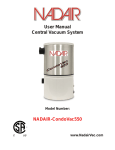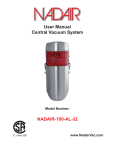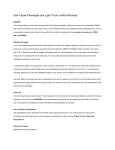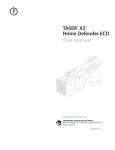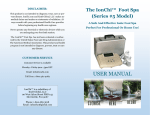Download the Leader`s Guide
Transcript
! 4720 Pre-Trip Inspection on a Conventional Bus Leader’s Guide and Quiz Introduction One of the primary reasons for school bus safety is the daily pre trip inspection of the school bus. This video will demonstrate in detail how to perform the pre trip of a school bus. The bus used in the video is a conventional school bus with a dual air brake system. An important reminder for all school bus drivers is to recognize that each school bus manufacturer will have a slightly different layout of switches, gauges and other component parts on the school bus. The driver must realize this and each time the driver uses a bus they are unfamiliar with, it will be necessary to go over the layout of the new bus. In addition, school bus drivers must be aware of the pre trip procedure of their school district. Drivers should defer to the policies of their school district and if it isn’t clear what these policies are, the driver should contact their supervisor for instructions. The school bus instructor for this video is John Vezaldenos, a California Certified State Instructor. I - Start of the Pre Trip Inspection 1. John checks underneath and around the bus for cracks or imperfections. 2. John sets chocks to make sure bus is secure during inspection. 3. John enters the bus to begin the first phase of the Pre Trip Inspection. II - Checking the Switches and Gauges inside the school bus 1.The driver begins the interior pre trip by making sure the parking brake is set. He turns the key to the on position and starts the bus. 2 2. The driver starts checking gauges on the dash including: a. Transmission temperature should be below 200 degrees. b. Water temperature should be below 200 degrees. c. Oil temperature between 40 and 70. d. Rev the tachometer to make sure it’s working. e. Speedometer will be checked later when bus is moved. f. Volt meter should be between 12 to 15 degrees. g. Check fuel gauge to make sure it has at least a half a tank. 3. The driver continues checking gauges and switches. This includes: various settings for electric fans, heaters, interior lights, including dome lights, windshield wipers, headlights, clearance lights, hazards, master switch for reds and ambers. John also checks to make sure all indicator lights are working. (Note - keep in mind that the positioning of the gauges and switches varies widely on each different bus the driver will be operating. The bus driver must take the time to familiarize themselves with each new bus they are operating.) 4. The driver continues checking switches including: the step well light, dome lights, power switches for red and ambers lights, and he also checks the horn to make sure it’s working. Once the driver has completed checking all the switches on the bus, he’s ready to make his first trip around the exterior of the bus. III - First trip around the exterior of the bus 1. The driver starts with the tires. Tires must have a minimum of 4/32nds tread depth on front tires. The driver makes sure there are no bumps, bulges, bruises or cracks on tires. Rims of tires must be free of rust, welds or cracks. Lug nuts must be secure and tight. Valve stems must be secure. 3 2. Check mirrors on front and side of the bus to make sure they are secure. 3. Come out to the front of bus and check the following to make sure they are working: Clearance lights, amber lights and windshield. Check for cracks and debris. Also check hazards and headlights (hi beams) to make sure they are working. Make sure nothing is dripping or hanging underneath the bus and make sure the license plate is secure. 4. Move to left side of bus and check clearance lights and reflector. Pull out batteries to make sure batteries are free of spillage or corrosion. Check on hazard lights and rear mud flaps. Check the rear tire. It must have a minimum tread depth of 2/32nds. 5. Next, the driver checks out the rear of the bus. Highlights - Check the legibility of the lettering on the bus including: emergency exit door and stop when red lights are flashing. Check to make sure lights are working including: clearance lights, amber and hazards. Also make sure bumper and tail lights are secure and working. And check that the lights and buzzer are working for the emergency exit door. 6. The driver will then check out the right side of the bus following similar procedures that he completed for the left side of the bus. IV - Interior of bus, drivers compartment 1. The driver reenters the bus to continue the pre trip inspection. 2. The driver turns off the Hazards, activates the left turn signal, turns on high beams, checks both indicator lights and hits the override switch for the red lights. 3. Next the driver will need to check the brake lights. He wedges a hammer under the brake pedal to activate the brake light. 4 V - Second Trip Around the Bus 1. The driver goes to the front of the bus and checks the following to make sure they are working: red lights, headlights on hi beam, and left side turn signal. 2. The driver then checks the left side of the bus. He checks turn indicator and stop arm to make sure they are working. 3. The driver then goes to rear of bus and checks the following: Red lights, the left turn signal, the back up lights and the buzzer after the bus is placed in reverse. VI - Driver returns to bus 1. He removes the hammer under the brake pedal, turns off red light switches, hi beams, left turn indicator and then he activates the right turn signal. 2. The driver then goes outside the bus to make sure the right turn signal is working. VII - Additional Pre Trip Items 1. Additional items include: vehicle registration,current insurance certificate,body fluid kit and a seat belt cutter. 2. Check to make sure 1st aid kit is properly stocked. 3. Check fire extinguisher and make sure it’s properly set up. 4. Check roof hatch to make sure it’s working. 5. Check reflectors and emergency door release. 6. Make sure driver’s seat is properly adjusted. 7. Check seats and modesty panels and make sure no debris is left on the floor. 8. Check windows and use proper ergonomics to avoid back strain. 9. Adjust mirrors including: flat, convex, cross view and rear view mirrors. 10 Check wheelchair lift. Make sure lap belt is working and test the buzzer of the lift. 5 VIII - Brake tests for buses using an air brake system 1. Governor Cut In and Cut Out Brake Test a. John explains the reasons for the governor cut in and cut out brake test. b. John explains that during this test the governor will cut in no lower than 85 PSI. c. He also explains that when running through the test, when the air governor cuts out so the compressor stops putting air in the tank, it should not be above 130 PSI. d. John explains that the governor is the “brains” of the whole operation and the worker is the compressor. e. John explains that the point of the test is to show how the cut in and cut out PSI’s are a way to make sure the air tanks stay in balance. The cut in and cut out PSI’s are critical standards that drivers must test before operating their buses. 2. Demonstration of cut in/cut out brake test. a. The test starts with John waiting for the needles to cut out. He patiently waits until both needles hit 125 PSI. b. Next he applies a brake application and begins to let air out of the tanks. He waits for the needles to start moving and continues to do brake applications. c. He waits until the governor activates the compressor and the compressor begins putting air into the tanks. d. John is taking a small amount of air out of the tanks each time he applies the service brake. He wants to know within a few pounds where the governor cuts in. e. Minimum cut in on the air brake is 85 PSI. The demonstration shows that the compressor cuts in before we get to that point. f. Now the compressor will begin building air back up.The compressor is activated just above 100 PSI. John watches to see where the governor cuts out, and remember the maximum pressure it can cut out is 130 PSI. g. The governor cuts out at 124 PSI on both tanks. This completes the test. 6 . The Static Air Pressure Test a. Explanation of test - When the spring brake is applied, there should be no air loss in the spring brake chamber. b. What the driver should be looking for during the test: The driver should be looking for a static air loss that should be coming from somewhere in the air lines or the air tanks that would detect a leak. c. The test begins with John applying the spring brake. d. When testing the spring brake, the tanks can’t increase by more than 2 PSI. If it does, this means the bus has failed the static air test. e. The test continues with the driver monitoring the needle on the air tank gauges for one minute. John notes that the needles on the gauges stays static. This means there is no air loss. This successfully concludes the static air pressure test. 4. Applied Brake Test a. Explanation of test: When the spring brake is released, air is put into the spring brake chamber. The air collapses the spring brake inside the spring brake chamber and this in turn releases the spring brake. The pressure inside that chamber is what is keeping the spring brake released. b. John begins the test by monitoring the brake chambers to see if there is any air loss. c. First he releases the spring brake and looks for any loss in air pressure. d. Next he applies a full application of the service brake. e. John will monitor the gauges for a full minute. There is no loss of air pressure. f. The test is concluded successfully. 5. Low Air Light and Buzzer Test a. Explanation: During this test, the driver wants to make sure that the low air light and buzzer comes on no lower than 60 PSI and it stays on at all points below. 7 By doing this, we will slowly exhaust the air from the front and rear service tank until we hear and see the lower air service light and buzzer come on. Be aware that we want the warning light and buzzer to tell us that there is a problem that could incapacitate the bus. a. The test begins with turning the key to the on position. b. Next pump the service brake to lower the air pressure in the air tanks. c. The low light and air buzzer activates at approximately 60 PSI. d. Next, start start the bus and let the air build up to approximately 100 PSI to make sure the air brake system and anything that is operated by it, has enough air pressure to operate the bus. Service Brake Test a. Move the bus forward at approximately 5 miles per hour. b. Step on the service brake to make sure the bus doesn’t pull to either side. c. Test the bus a second time to make sure the bus stops properly. Spring Brake Test a. Release the spring brake and get the bus moving very slowly. b. Next apply the spring brake and make sure the bus can stop and hold itself in place. c. This completes the tests for buses with an air brake system. IX Hydraulic Brake Test 1. John will perform the hydraulic brake test according to the service manual. a. John pumps the brake 3 times and then holds the brake pedal down and waits for 5 seconds. b. Next, he checks the dash panel and makes sure the brake light doesn’t come on. This would indicate there is a problem with the brake system. 8 c. Next, John releases the brake. The light doesn’t come on. The test is successful. d. A final precaution for the hydraulic brake test is to move the bus forward slowly and apply the service brake firmly. Check to make sure the bus doesn’t pull to the right or left side. e. There are variations on the hydraulic brake tests for each bus manufacturer. Make sure to refer to your the owner’s manual for the proper procedure that applies to the bus you are operating. The pre trip inspection of a school bus pays dividends, so take the time to always perform a pre trip inspection of the school bus you are driving. Also, make sure to follow the guidelines that are in place for your school district. 9 Test Questions for the Pre Trip Inspection of the School Bus 1. If one of the lesser important gauges on the school bus is not working properly, report it to the maintenance department, after you have completed your route. True or False 2. It is not necessary to go over the layout of the switches on a new school bus, because buses utilize the same types of switches, regardless of what kind of bus you are operating. True or False 3. If it’s raining or snowing, pre tripping the exterior of the school bus isn’t a necessity because the gauges inside the bus are a reliable indicator of whether the lights and warning devices are working properly. True or False 4. A driver’s physical size may require mirrors on the outside of the bus to be adjusted to fit the size of each individual driver. True or False 5. If a driver arrives at the bus yard late, is it okay to ignore some of the less important pre trip procedures, so that it will be possible to pick up their students on time. True or False 6. The cut in and cut out brake test is used to show that both the front and rear air tanks are in balance. True or False 10 7. During the static air pressure test, if one of the dual air tanks shows a loss of 10%, this is okay as long as the other air tank doesn’t exceed an air loss of 2%. True or False 8. During the low air light and buzzer test, the light and buzzer should come on at no lower than 20 PSI. True or False 9. When testing the service brake and spring brake, the bus should be accelerated to 15 to 20 mph. This will allow the driver to see if the brakes are working under normal driving conditions. True or False 10. Testing hydraulic brake systems differs depending on the make and manufacturer, so the driver should always refer to their owner’s manual for the suggested guidelines for testing the brake system. True or False 11 ANSWER KEYS 1. False 2. False 3. False 4. True 5. False 6. True 7. False 8. False 9. False 10. True 12












